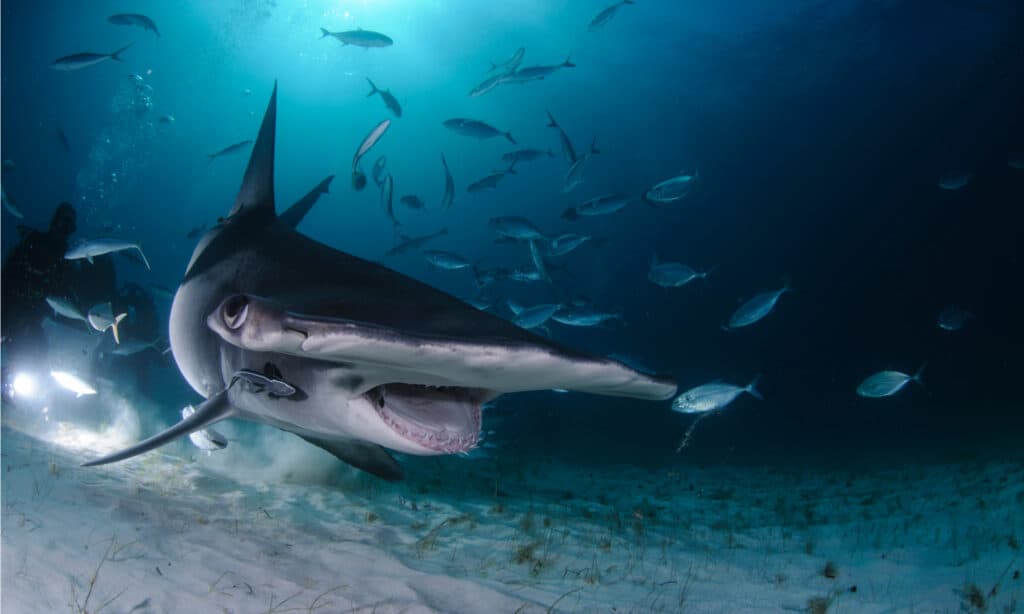Hammerhead sharks are some of the most recognizable sharks in the world due to their unique “hammer-shaped” heads. There are several species of hammerhead sharks and they range in size from less than two feet long to almost 20 feet. Hammerhead sharks inhabit seas around the world, but this doesn’t necessarily mean that they are in a strong position population-wise. In fact, they actually face several major threats. But are hammerhead sharks endangered? Let’s find out!
All About Hammerhead Sharks

Hammerhead sharks are known for their distinctive appearance which typically includes a “T-shaped” head.
©Sail Far Dive Deep/Shutterstock.com
There are nine species of hammerhead sharks, and they vary in size from the smallest bonnethead at 2.5 feet long, up to the great hammerhead which has a maximum length of 20 feet. Although these sharks are collectively called “hammerhead” sharks, they don’t all have a typical T-shaped appearance. Instead, some have a more scalloped shape or rounded appearance.
Hammerhead sharks inhabit waters all around the world, in both temperate and tropical waters. They can be observed both far offshore and around the coastline. Some species of hammerheads can often be seen swimming in large schools of up to 100 individuals, although they typically always hunt alone. Their diet depends on the species of shark, with smaller hammerheads preying on smaller animals such as snails and crabs and larger species preying on fish, rays, and skates. Great hammerheads, in particular, are considered to be apex predators.
How Many Hammerhead Sharks Are There in the World?
There is currently no reliable data about the population size of hammerhead sharks, owing largely to the fact that it is so difficult to count them. However, all but one of the nine species is classified as Endangered according to the IUCN Red List. The populations of these eight species are considered to be decreasing, and five of the species are considered to be Critically Endangered, including the great hammerhead.
Check out the chart below.
| Species | Status |
|---|---|
| Great Hammerhead | Critically Endangered |
| Smooth Hammerhead | Vulnerable |
| Smalleye Hammerhead | Critically Endangered |
| Bonnethead | Endangered |
| Scoophead | Critically Endangered |
| Scalloped Hammerhead | Critically Endangered |
| Scalloped Bonnethead | Critically Endangered |
| Winghead Shark | Endangered |
| Carolina Hammerhead | Data Deficient |
Are Hammerhead Sharks Under Threat?

Eight of the nine species of hammerhead sharks are considered to be under threat.
©iStock.com/Michael Zeigler
With the vast majority of hammerhead sharks being endangered in some way and their populations decreasing, the question is raised as to why this is happening. Unfortunately, hammerhead sharks are threatened for a few reasons, but we humans are the main factor.
Commercial Fishing
The biggest threat to hammerhead sharks is commercial fishing. For a start, many sharks are caught and killed for their fins, which are then used to make shark fin soup. Great hammerheads are particularly sought after for this trade as, being the largest species of hammerhead, they have the largest fins and therefore the highest monetary value. The demand for shark fins is high, which leads to overfishing which the populations are unable to cope with. Although several countries are attempting to ban the practice, it is virtually impossible to police.
However, it’s not just the intentional capture of hammerhead sharks that is affecting their population, as many of these sharks are actually caught as bycatch while fishing for other species.
Habitat Degradation
Many hammerhead sharks live close to coastlines, and factors such as coastal development and pollution degrade their habitat. This not only affects the sharks themselves but the animals that they prey on too, having a two-fold effect on them.
Reproductive Rate
Most species of hammerhead sharks have a fairly slow growth rate as well as a slow reproductive rate. For instance, great hammerheads give birth to between six and 55 pups — but only once every two years. This, combined with overfishing, means that the population struggles to recover.
What Are the Conservation Efforts?

Conservation efforts to protect these sharks include attempting to minimize the risk of them being caught as bycatch.
©Martin Voeller/Shutterstock.com
Conservation work is ongoing around the world to try to protect these fascinating sharks. Efforts by organizations include working with members of the Convention on International Trade in Endangered Species of Wild Fauna and Flora (CITES) to limit or ban the trade of shark fins from endangered species. In particular, meat from species listed in this Appendix is not allowed to be exported unless it can be proven that it is not affecting their survival in the wild.
Also, the World Wildlife Fund (WWF) is working with fisheries around the world to come up with solutions to prevent all sharks, not just hammerheads, from being caught as bycatch.
Furthermore, work is ongoing to create more protected areas so that species can flourish without threat. Organizations are also promoting responsible marine tourism as it is an avenue that benefits from thriving populations of these animals.
The photo featured at the top of this post is © Martin Prochazkacz/Shutterstock.com
Thank you for reading! Have some feedback for us? Contact the AZ Animals editorial team.






